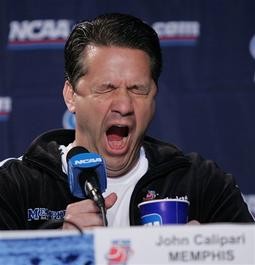As you frantically fill out your brackets before the first full day of the NCAA men’s basketball tournament this Thursday, let your instincts do their thing … unless you have doubts. Not that I’m an expert on bracketology, by any stretch (I’ve picked two champions in over 20 years of trying: Indiana in 1987, Kentucky in 1996). But I’ve learned some lessons in this office-unifying enterprise. Whether or not they help you win a pool or two … well, that’s up to you.

• Pick against the top two seeds at your peril. There’s a reason John Calipari was so wound up this time of year, one season after another. The path to the tournament’s second weekend is considerably shorter and straighter for teams that must face seeds no higher than seventh in the second round. Surviving that first weekend — and the nerves it brings, particularly for first-time players — is an obvious but critical hurdle to leap.
• Top seeds are earned. You may love upsets, and some pools reward a pick that has the likes of Richmond or Rhode Island — to name a pair of Cinderellas from days gone by — beating the likes of Indiana or Syracuse. But you can all but count on a top seed reaching the Final Four. (Of course, this means you have a 25-percent chance of nailing the pick if you limit yourself to one, so be careful.) Over the 31 years the NCAA has seeded teams, only twice — in 1980 and 2006 — has the Final Four been devoid of a numero uno.
• If you want to tempt the fates, look at the 15th seed in each bracket. No 16-seed has ever won a game at the NCAA’s (since the field was expanded to 64 in 1985). But four 15-seeds have pulled upsets (Richmond in ’91, Santa Clara in ’93, Coppin State in ’97, and Hampton in ’01). The lowest seeds to reach the Final Four, by the way, were 11th: LSU in 1986 and George Mason in 2006.
• Look at last year’s winner … and forget them. Literally, this year. North Carolina ran roughshod through the field a year ago, but with Tyler Hansbrough and Ty Lawson now cashing checks in the NBA, the Tar Heels didn’t even make the field (first time since 2003). Two years ago, history was made when all four top seeds reached the Final Four (including Derrick Rose’s Memphis Tigers). This month, only one of those programs — Kansas — will be dancing. College basketball has taken on the collective shape of its biggest stars: one and done. So pay absolutely no attention to last year’s results.
• Star power matters; experience, not so much. Greg Oden and Mike Conley played one year of college hoops, and took their Ohio State Buckeyes to the national finals in 2007. Rose needed only one season at Memphis to make himself a national star (and ultimately the top pick in the NBA draft) as he led the Tigers to the 2008 finals. Carmelo Anthony won a championship as a one-and-done force for Syracuse in 2003. Mike Bibby was a freshman when his Arizona Wildcats won it all in 1997. And who can forget Michigan’s Fab Five going to the Final Four as freshmen and sophomores (1992 and ’93). So . . . look long and hard at this year’s Kentucky Wildcats, with freshmen John Wall and DeMarcus Cousins sharing the role of Calipari’s annual one-year-wonder.
• Just fill out the bracket! Don’t be shy. Expertise during March Madness is highly overrated. (Just count the number of sportswriters who have retired on their success in Vegas.) There are 9.2 quintillion possibilities in a 64-team bracket, and somewhere among those possibilities is “one shining moment” we all await when the nets are finally cut down on a Monday night in early April. Have fun. And when in doubt, always bet on the team with an animal nickname.